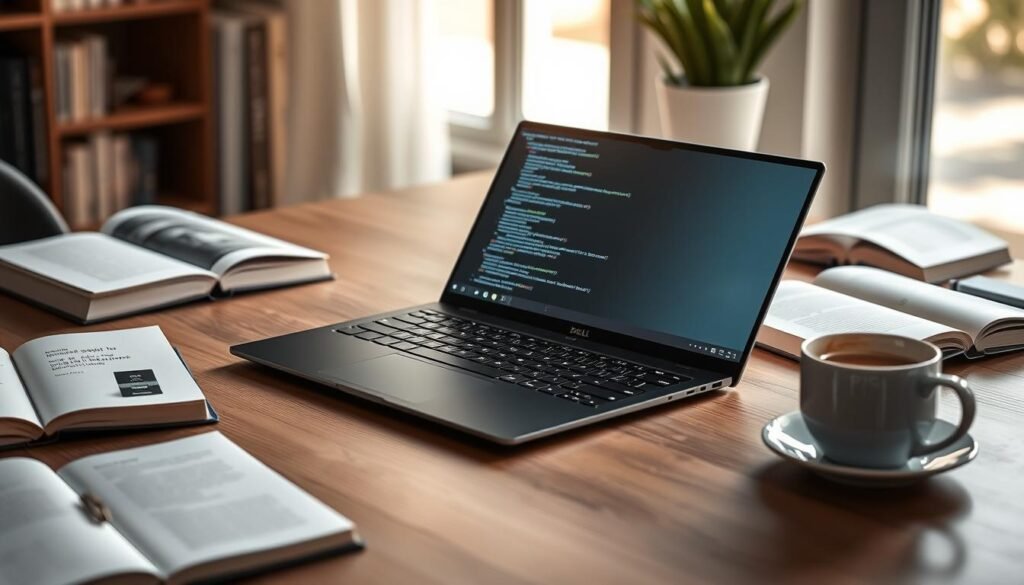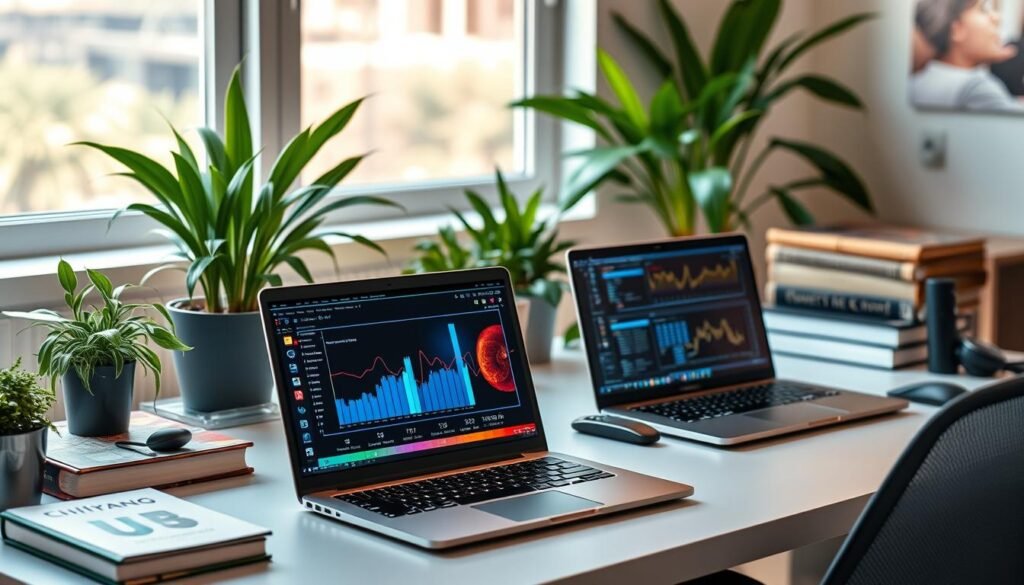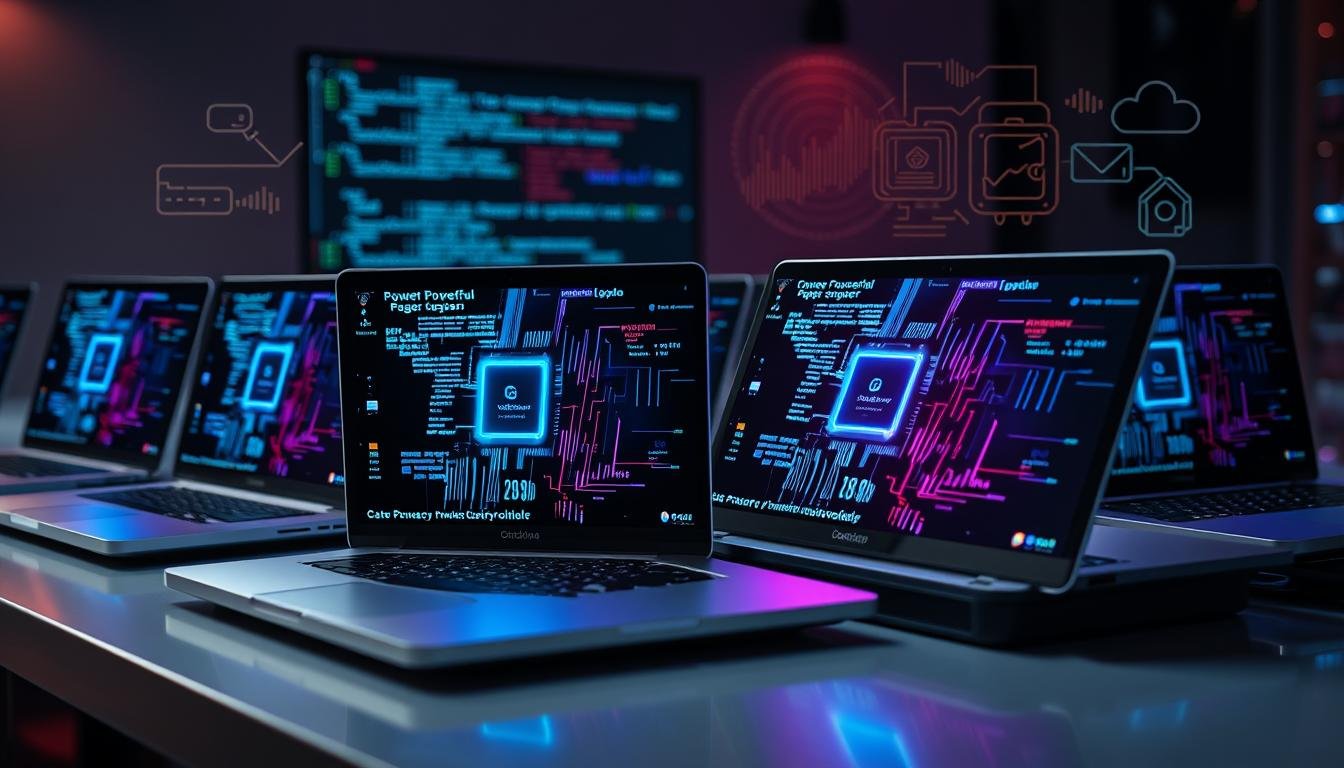“The programmer, like the poet, works only slightly removed from pure thought-stuff. He builds his castles in the air, from air, creating by exertion of the imagination.” – Fred Brooks
In the world of coding, your laptop is your creative canvas. The right machine can make the difference between smooth sailing and frustrating roadblocks. As we dive into 2024, the landscape of coding laptops has evolved, offering developers powerful processors, high-performance GPUs, and ample RAM to tackle complex projects with ease.
This guide aims to navigate you through the maze of options, highlighting the best coding laptops that cater to various needs and budgets. We’ll explore machines that boast cutting-edge specs, ensuring you have the horsepower to compile code, run virtual machines, and handle resource-intensive tasks without breaking a sweat.
From budget-friendly options to high-end powerhouses, we’ve got you covered. Let’s embark on this journey to find the perfect coding companion that will fuel your development projects in 2024 and beyond.
Key Takeaways
- Powerful processors are crucial for smooth coding experiences
- High-performance GPUs enhance multi-tasking and visualization
- Ample RAM is essential for running multiple applications simultaneously
- SSD storage significantly improves system responsiveness
- Battery life and portability are important for on-the-go developers
- Consider future-proofing your laptop choice for longevity
Why Choosing the Right Laptop Matters for Developers
Selecting the perfect laptop is crucial for developers. The right machine can boost productivity and make coding a breeze. Let’s explore key factors to consider when picking your next development powerhouse.
Performance Over Price: What to Consider
When shopping for a coding laptop, prioritize performance. A fast processor and ample RAM are essential for smooth coding sessions. Developers often need to run multiple resource-intensive simultaneously. Don’t skimp on these specs to save a few bucks.
Portability vs. Power: Finding the Balance
Striking a balance between portability and power is key. Lightweight and portable laptops are great for on-the-go coding. But they might sacrifice some performance. Consider your work style and needs when making this trade-off.
The Importance of Development-Specific Features
Look for features that cater to developers’ needs. Long battery life is crucial for coding marathons away from outlets. Linux compatibility opens up a world of open-source tools. A comfortable keyboard and crisp display reduce eye strain during long coding sessions.
| Feature | Importance | Impact on Development |
|---|---|---|
| Long battery life | High | Enables uninterrupted coding sessions |
| Lightweight and portable | Medium | Facilitates coding on-the-go |
| Linux compatibility | High | Provides access to diverse development tools |
By considering these factors, you’ll be well-equipped to choose a laptop that enhances your coding experience and boosts your productivity as a developer.
Top Features to Look for in Coding Laptops
Choosing the right laptop for coding is crucial. It can make or break your productivity as a developer. Let’s dive into the key features you should consider when picking a laptop for your coding needs.
Processor: Intel vs. AMD
The processor is the brain of your laptop. Both Intel and AMD offer great options for coding laptops. Intel’s Core i5 and i7 processors are popular choices, while AMD’s Ryzen series provides excellent performance for multitasking. The right choice depends on your specific coding needs and budget.
RAM Requirements: How Much is Enough?
RAM is vital for running multiple software developer tools simultaneously. For most coding tasks, 8GB is the minimum, but 16GB is ideal. If you’re into heavy-duty development or running virtual machines, consider 32GB or more.
| RAM | Suitable for |
|---|---|
| 8GB | Basic coding, light IDEs |
| 16GB | Most development tasks, multiple coding environments |
| 32GB+ | Complex projects, virtual machines, data science |
Storage Options: SSD vs. HDD
SSDs are faster and more reliable than HDDs, making them ideal for coding laptops. They speed up boot times and launch code editors quickly. A 256GB SSD is sufficient for most developers, but consider larger capacities if you work with big datasets or multiple projects.
Remember, your laptop should seamlessly run various coding environments and support the code editors you prefer. A balance of these features will ensure a smooth coding experience, allowing you to focus on building great software.
Best Budget Coding Laptops for Developers
Finding a laptop that balances cost and performance can be tricky for developers on a budget. We’ve picked out three top contenders that offer powerful processors, ample RAM, and long battery life without breaking the bank.
Acer Aspire 5: A Value Champion
The Acer Aspire 5 packs a punch with its Intel Core i5 processor and 8GB of RAM. It’s a solid choice for coding tasks, offering smooth performance at an affordable price point. The 15.6-inch Full HD display provides ample screen real estate for multitasking.
Lenovo IdeaPad 3: Affordable Flexibility
Lenovo’s IdeaPad 3 strikes a balance between portability and power. With AMD Ryzen processors and up to 8GB of RAM, it handles coding projects with ease. Its compact design makes it perfect for developers who need to code on the go.
Asus VivoBook: Performance Meets Price
The Asus VivoBook 15 offers impressive specs for its price range. Featuring Intel Core i5 or i7 processors and up to 16GB of RAM, it’s capable of handling demanding development tasks. The NanoEdge display maximizes screen space in a compact form factor.
| Model | Processor | RAM | Battery Life |
|---|---|---|---|
| Acer Aspire 5 | Intel Core i5 | 8GB | Up to 8 hours |
| Lenovo IdeaPad 3 | AMD Ryzen 5 | 8-12GB | Up to 7 hours |
| Asus VivoBook | Intel Core i5/i7 | 8-16GB | Up to 6 hours |
These budget-friendly options prove that powerful processors and ample RAM don’t have to come with a hefty price tag. While battery life varies, all three models offer enough juice to keep you coding through long sessions.
Mid-Range Coding Laptops Worth Considering
Finding the right balance between price and performance is crucial for developers. Mid-range laptops offer a sweet spot, combining powerful features with affordability. Let’s explore two standout options that cater to the needs of coders.
Dell XPS 13: Compact and Powerful
The Dell XPS 13 is a favorite among developers for its lightweight and portable design. Weighing just 2.6 pounds, it’s perfect for coding on the go. Its 13.4-inch InfinityEdge display provides ample screen real estate for programming tasks. The laptop boasts impressive performance with Intel’s latest processors and up to 32GB of RAM, handling complex software developer tools with ease.

Microsoft Surface Laptop 5: Design Meets Performance
The Microsoft Surface Laptop 5 combines sleek design with powerful performance. Its 13.5-inch PixelSense touchscreen offers crisp visuals for long coding sessions. The laptop features Intel Iris Xe graphics, providing smooth performance for light to moderate GPU tasks. With its all-day battery life and compatibility with popular development environments, it’s an excellent choice for programmers who value both style and substance.
| Feature | Dell XPS 13 | Microsoft Surface Laptop 5 |
|---|---|---|
| Weight | 2.6 lbs | 2.86 lbs |
| Display | 13.4″ InfinityEdge | 13.5″ PixelSense Touchscreen |
| Max RAM | 32GB | 32GB |
| Graphics | Intel Iris Xe | Intel Iris Xe |
Both laptops offer excellent value for developers, striking a balance between performance and portability. Your choice may depend on personal preferences for design, operating system, and specific coding needs.
Premium Laptops for Software Development
Software developers need top-notch machines to handle complex coding tasks. Premium laptops offer powerful processors, high-performance GPUs, and seamless compatibility with code editors. Let’s explore three standout options for professional developers.
Apple MacBook Pro 14: The Developers’ Favorite
The MacBook Pro 14 is a favorite among developers. Its M1 Pro chip delivers exceptional performance for compiling code and running virtual machines. The Retina display provides crisp visuals, making long coding sessions comfortable. With its optimized macOS, it’s ideal for iOS and macOS app development.
Razer Blade Stealth 13: Gaming Power for Coding
Razer’s Blade Stealth 13 combines gaming prowess with coding capabilities. Its NVIDIA GeForce GTX 1650 Ti Max-Q GPU handles graphics-intensive tasks with ease. The laptop’s sleek design and portability make it perfect for developers who need power on the go.
HP Spectre x360: Flexibility and Elegance
The HP Spectre x360 offers versatility for developers. Its 2-in-1 design allows for tablet-mode coding or traditional laptop use. With Intel Iris Xe Graphics and a 4K OLED display, it’s great for UI/UX designers who code. The Spectre x360 balances performance and style effortlessly.
| Laptop | Processor | GPU | Display |
|---|---|---|---|
| MacBook Pro 14 | M1 Pro | Integrated | 14″ Retina |
| Razer Blade Stealth 13 | Intel Core i7 | NVIDIA GTX 1650 Ti | 13.3″ FHD |
| HP Spectre x360 | Intel Core i7 | Intel Iris Xe | 13.5″ 4K OLED |
These premium laptops offer the power and features developers need. Whether you prefer macOS, Windows, or need a flexible 2-in-1, there’s an option to suit your development style and preferences.
Best Laptops for Data Science and Machine Learning
Data science and machine learning demand powerful hardware. The right laptop can make a huge difference in your productivity and efficiency. Let’s explore some top choices that offer ample RAM, high-performance GPUs, and support various coding environments.

Lenovo ThinkPad X1 Carbon: Built for Tough Tasks
The Lenovo ThinkPad X1 Carbon is a workhorse for data scientists. Its robust build quality and powerful specs make it ideal for crunching big data. With up to 32GB of RAM and blazing-fast SSDs, it handles complex algorithms with ease. The 14-inch 4K display provides crisp visuals for detailed data analysis.
MSI Prestige 14: A Great Balance of Power
MSI Prestige 14 offers a perfect blend of performance and portability. It packs a punch with its NVIDIA GeForce GTX graphics card, making it suitable for GPU-accelerated machine learning tasks. The laptop’s slim design doesn’t compromise on power, featuring up to 16GB RAM and a speedy Intel Core i7 processor.
Both laptops excel in different aspects of data science and machine learning. The ThinkPad X1 Carbon shines in CPU-intensive tasks, while the MSI Prestige 14 is great for GPU-accelerated machine learning. Your choice depends on your specific needs in coding environments and computational requirements.
| Feature | Lenovo ThinkPad X1 Carbon | MSI Prestige 14 |
|---|---|---|
| RAM | Up to 32GB | Up to 16GB |
| GPU | Integrated Intel Iris Xe Graphics | NVIDIA GeForce GTX |
| Best For | CPU-intensive tasks | GPU-accelerated learning |
Remember, the best laptop for you depends on your specific data science projects and preferred coding environments. Consider your budget, portability needs, and the complexity of your machine learning models when making your choice.
The Role of Graphics Cards in Development Laptops
Graphics cards play a crucial role in development laptops, impacting performance in various coding environments. While not always essential, they can significantly enhance the capabilities of software developer tools.
Integrated vs. Dedicated Graphics: What’s Better?
Integrated graphics are built into the CPU, offering decent performance for basic coding tasks. They’re energy-efficient and cost-effective. Dedicated graphics cards, on the other hand, provide superior performance for demanding applications.
For most coding tasks, integrated graphics suffice. But if you work with 3D rendering, game development, or machine learning, high-performance GPUs become essential.
Laptop GPUs: Which Ones Are Sufficient for Coding?
The GPU requirements for coding depend on your specific needs:
- Web Development: Integrated graphics are usually sufficient
- Mobile App Development: Mid-range dedicated GPUs can improve emulator performance
- Game Development: High-end GPUs are often necessary for real-time rendering
- Data Science: GPUs can significantly speed up machine learning tasks
When choosing a laptop for development, consider your coding environments and the software developer tools you’ll be using. This will help you determine whether you need a powerful dedicated GPU or if integrated graphics will meet your needs.
Considerations for Battery Life When Coding
For developers on the go, long battery life is crucial. Laptops with extended power offer freedom to code in various environments without constantly hunting for outlets. Let’s explore what to expect from today’s coding laptops and how to maximize their battery performance.
Average Battery Life Expectations
Battery life varies widely among laptops. Lightweight and portable models designed for coding environments typically offer between 8 to 12 hours of use. High-performance laptops may sacrifice some battery life for power, averaging 6 to 8 hours.
| Laptop Category | Average Battery Life | Best For |
|---|---|---|
| Ultrabooks | 10-14 hours | Mobile developers |
| Mid-range | 8-10 hours | Balanced coding needs |
| High-performance | 6-8 hours | Resource-intensive tasks |
Tips to Optimize Battery Performance
Extend your coding sessions with these battery-saving strategies:
- Dim screen brightness
- Close unused applications
- Use power-saving modes
- Disable background processes
- Keep your laptop cool
By following these tips, you can significantly increase your laptop’s battery life, allowing for longer coding sessions in various environments.
Remember, the ideal coding laptop balances performance with portability. Choose a device that meets your specific needs, considering factors like battery life, weight, and processing power to create your perfect mobile coding setup.
Best Operating Systems for Development Work
Choosing the right operating system can significantly impact a developer’s productivity. Let’s explore the top contenders and their unique features for coding tasks.
Windows vs. macOS: Preferences of Developers
Windows and macOS are popular choices among developers. Windows offers a wide range of software developer tools and supports many programming languages. Its flexibility allows for easy customization of development environments.
macOS, favored by many due to its Unix-based architecture, provides a seamless experience for web and mobile app development. It comes with pre-installed developer tools and offers excellent support for code editors.
| Feature | Windows | macOS |
|---|---|---|
| Price | Varies | Premium |
| Software Compatibility | High | Good |
| Development Tools | Extensive | Built-in |
| User Interface | Customizable | Sleek |
Linux: A Tool for Open Source and Beyond
Linux stands out for its Linux compatibility and open-source nature. It’s a favorite among developers who value control over their system and enjoy working with diverse programming languages.
- Customizable environments
- Robust command-line interfaces
- Extensive package managers
- Support for various code editors
Ultimately, the choice depends on personal preference, project requirements, and familiarity with the system. Each OS offers unique advantages for different coding tasks.
How to Maintain Your Laptop for Long-Term Use
Keeping your laptop in top shape is crucial for developers who rely on their machines for coding environments and software developer tools. A well-maintained laptop ensures smooth performance and long battery life, essential for productive coding sessions.
Regular Software Updates: Keeping Your System Clean
Updating your operating system and software is key to maintaining a healthy laptop. Regular updates patch security vulnerabilities, improve performance, and add new features to your coding environments. Set up automatic updates to ensure you’re always running the latest versions.
- Update your operating system monthly
- Keep development tools and IDEs current
- Regularly clean up temporary files and caches
Hardware Care: Tips for Longevity
Physical maintenance is just as important as software upkeep. Proper care can extend your laptop’s lifespan and maintain its performance for software development tasks.
| Area | Maintenance Task | Frequency |
|---|---|---|
| Keyboard | Clean with compressed air | Monthly |
| Screen | Wipe with microfiber cloth | Weekly |
| Vents | Remove dust buildup | Quarterly |
| Battery | Calibrate and avoid overcharging | Every 3 months |
By following these maintenance practices, you’ll ensure your laptop remains a reliable companion for your coding projects, offering long battery life and optimal performance for your software developer tools.
Conclusion: Finding the Best Coding Laptop for You
Choosing the right laptop for coding is a personal journey. The best coding laptops for developers offer a mix of powerful processors and high-performance GPUs. Your specific needs play a crucial role in this decision.
Personal Needs vs. General Recommendations
While general recommendations are helpful, your unique requirements should guide your choice. Consider factors like your preferred programming languages, development environment, and budget. A laptop perfect for web development might differ from one ideal for machine learning projects.
Future-Proofing Your Choice
Investing in a laptop with room for growth is wise. Look for devices with upgradeable components and the latest technology. This approach ensures your laptop can handle evolving coding demands and new software requirements over time.
Final Thoughts on Your Coding Journey
Remember, the best coding laptop is one that empowers your work. Whether you opt for a budget-friendly option or a high-end powerhouse, prioritize features that align with your coding goals. With the right tool in hand, you’ll be well-equipped to tackle any programming challenge that comes your way.
